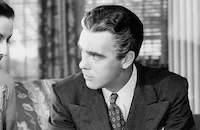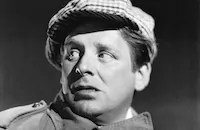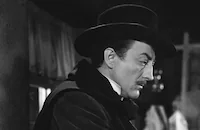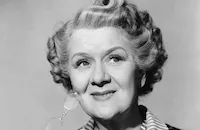A Lawless Street

Brief Synopsis
Cast & Crew
Joseph H. Lewis
Randolph Scott
Angela Lansbury
Warner Anderson
Jean Parker
Wallace Ford
Film Details
Technical Specs

Synopsis
The return of notorious outlaw Dingo Brion to the small town of Medicine Bend in the Colorado territory sets the townspeople gossiping and worries stern marshal Calem Ware, whom Brion has promised to kill. Brion's return coincides with the arrival of a theatrical group, headed by beautiful star Tally Dickinson, whom theater owner and businessman Hamer Thorne hopes to marry. While Calem is getting shaved at the barbershop, Brion bursts in and draws his gun, but Calem kills him with a derringer and stalks away, despite sarcastic barbs from saloon owner Cody Clark. Only Doc Amos Wynn and Calem's landlady, Molly Higgins, see how much the marshal is affected by the attack, but both remain silent. Later, wealthy Asaph Dean drives into town with his wife Cora, who is having a secret romance with Thorne. Asaph meets with Calem to reassure the marshal that keeping Medicine Bend law-abiding will help Colorado achieve statehood. Doc brings Brion's effects to Calem, and the men agree that the hundred dollars found on the body prove that Brion was hired to kill Calem. Brion's widow and brother Dooley then come into town, and Dooley, who abhors gun violence, declares he bares no grudge against Calem, but refuses to take the hundred dollars. That evening at the dance hall show, Calem meets Tally in her dressing room and they are reunited after nine years. Unknown to everyone, Calem and Tally are married, but, as she was unable to accept Calem's violent lifestyle, she left him while still in love with him. The reunion is interrupted when Calem learns that Dooley is wrecking Clark's saloon, insulted by the town-wide collection of money made on the Brions' behalf at Calem's request. Calem and Dooley fight viciously until Dooley relents and is arrested. Tally views part of the brawl and is dismayed that Calem's life has not changed. A few days later, gunslinger Harley Baskam rides into town at the behest of Thorne and Clark, who hire him to kill Calem. Although Baskam has his own grudge against Calem, he asks the men why they want Calem killed, and Thorne explains that they hope to take over Medicine Bend in anticipation of a mining boom and fear that Calem will interfere. Although upset by Baskam's demand for one-third of the mining profits, Thorne and Clark eventually agree to the proposal. Mrs. Brion pleads for Dooley's release from jail, which Calem grants. Shortly afterward, Calem is nearly struck by a knife thrown by Juan Tobrez, who then dashes to Clark, claiming he hoped to get paid like Brion. Instead Clark kills Juan, and when Tally witnesses the threats exchanged by Calem and Clark, she makes reservations on the next stage out of town. She then informs Calem that she can no longer stay married to him because he continues to embrace violence, and will file for divorce in Chicago. That evening in Clark's saloon, Calem confronts Baskam, who shoots the marshal in the head. Doc declares Calem dead and Thorne and Clark immediately encourage the townspeople to celebrate. When Tally hears the news and sees the mayhem filling the streets, she weeps, finally understanding Calem's significance to the town. Thorne and Clark swiftly coerce all of the town's businesses to sell out to them and promote gambling and drinking with promises of employment at the new mines. Thorne rides out to Asaph's ranch to report Calem's death and advises him to stay out of town. Asaph laments the fall of Medicine Bend, and when Cora overhears Thorne blithely dismiss their affair, she goes into town. Doc informs her that Calem is dead, and Cora decries her foolishness for not taking action despite knowing about Thorne and Clark's plans for months. When Doc asks if she would testify against Thorne and Clark, Cora vows she will. The next day as Molly packs up Calem's clothes, Tally looks around his modest room and is surprised when Molly details Calem's goodness and long suffering to maintain order in the town. Later, Doc tells Tally that Calem is still alive, having only suffered a flesh wound, and is hidden at the jail, guarded by Dooley. When Tally insists she is still leaving town, Doc claims she is not good enough for Calem. Later, Tally comes to the jail, but Calem refuses to see her. That night, a restored Calem, hearing all the carousing in the streets, returns to town and begins closing down the gambling parlors and saloons. At Clark's saloon, Thorne and Clark quickly abandon Baskam upon learning of Calem's resurrection. Calem demands Baskam's surrender and when he refuses, dives into the saloon and kills him. Realizing that their hasty attempt to corrupt the town is crumbling, Thorne and Clark make plans to escape. Hearing Calem approaching the opera house, Thorne arms himself, but Calem hides when Clark arrives and Thorne accidentally kills his partner. Meanwhile, Asaph has rounded up the law-abiding citizens, who prevent Thorne from fleeing. When Asaph apologizes to Calem for forcing him to handle the town's problems single-handedly and vows to help, Calem presents him with his marshal's badge and declares that Asaph and Medicine Bend no longer need him if they realize that they can look after themselves. The next day, Molly and Doc see Calem and Tally off as they head for their new life on a ranch.

Director

Joseph H. Lewis
Cast

Randolph Scott

Angela Lansbury

Warner Anderson

Jean Parker

Wallace Ford

John Emery
James Bell

Ruth Donnelly

Michael Pate

Don Megowan
Jeanette Nolan
Peter Ortiz
Don Carlos
Frank Hagney
Charles Williams

Frank Ferguson
Harry Tyler
Harry Antrim
Crew
Jerry Antes
David Breen
George Brooks
Harry Joe Brown
Kenneth Gamet
Frank Goodwin
Gene Havlick
Henri Jaffa
John Livadary
Jack Mason
Ray Rennahan
Paul Sawtell
Randolph Scott
Abner E. Singer
Frank [a.] Tuttle

Videos
Movie Clip



Film Details
Technical Specs

Articles
A Lawless Street
Though Lewis never quite broke out of the low-budget end of Hollywood, he had a reputation for making the most of limited resources and injecting a touch of style and class into every assignment. In A Lawless Street he announces his presence in the memorable opening shot: a simply but elegantly executed long take that observes a rider approach the camera from a distance, moves in to study the man's hard, weather-beaten face, tilts down to reveal his holstered gun, and then pans around to the worried look of a citizen who recognizes trouble when he sees it. In one shot Lewis delivers tension, danger and anticipation, announcing a threat and setting the stage for a showdown. While the rest of A Lawless Street has a more conventional storytelling style, his eye for interesting camera angles, expressive compositions and thoughtful camera movement elevates the film above the standard western churned out by most studios in the fifties.
Like the majority of films from the long-running Randolph Scott cycle, A Lawless Street takes place in a frontier town with Scott playing a veteran lawman trying to hold back the forces of violence and chaos. Marshal Calem Ware's commitment to justice has cost him much -- in particular his marriage -- but he won't quit his post until he tames the "growling beast" of the town (a line he repeats throughout the script). Angela Lansbury makes her entrance with style: the leading lady of a traveling stage show, she is ushered into town on a stagecoach and introduced with great fanfare by the town's gambling baron (John Emery). But this oily showman's attempts to charm the famous showgirl are overshadowed by the marshal as he engages her in a conversation loaded with history: you can hear in their words and see in their looks and smiles that they know each other far more intimately than anyone in town could guess. The gambling man and marshal are at odds over more than just a woman; there's a struggle over control of the town and Emery and his partner (Warner Anderson), the owner of the shuttered mine, are conspiring to remove the marshal and turn this place into a lawless "wide open town."
Angela Lansbury began her career as a Hollywood ingénue in the forties but was always relegated to supporting status, and she eventually found her forte as a character actress of great command and range. A Lawless Street is one of her rare romantic leads and one of few films to showcase her talents as a singer and dancer. She was at her best playing characters who were conniving, calculating, witty or simply experienced in the ways of life and love. She plays the latter here with confidence and grace, a woman in love with Scott's lawman but unable to endure the anxiety of him putting his life on the line every day.
A Lawless Street features a bigger budget than most of Scott's films of the period but otherwise follows a familiar formula right to the end; Lewis makes the most of the budget with a relatively lavish portrait of chaos in the streets as drunken cowboys and racing horses send citizens scrambling for safety during the marshal's absence. But the movie also looks forward to the "sunset westerns" that Sam Peckinpah's Ride the High Country (1962, co-starring Scott as a leathery veteran lawman and gunfighter in a frontier that has no place for him anymore) helped popularize.
One of the most interesting hallmarks of Scott in his westerns of the fifties is that he plays his age. He moves like he's lived his entire life in frontier towns and on saddles and the experience is etched in his gaunt face and his lanky, aging body. The marshal maintains a front of strength and invulnerability in front of the townspeople, smiling and joking every morning with his rooming house landlady (Ruth Donnelly, a prolific character actress featured in so many snappy thirties pictures for Warner Bros.) while striding toward every potential showdown and gunfight with a grim purposefulness. Scott was confident enough an actor and cagey enough a producer to let his mortality show and it only makes his courage more impressive.
Producer: Harry Joe Brown
Director: Joseph H. Lewis
Screenplay: Kenneth Gamet; Brad Ward (story)
Cinematography: Ray Rennahan
Art Direction: George Brooks
Music: Paul Sawtell
Film Editing: Gene Havlick
Cast: Randolph Scott (Marshal Calem Ware), Angela Lansbury (Tally Dickenson), Warner Anderson (Hamer Thorne), Jean Parker (Cora Dean), Wallace Ford (Dr. Amos Wynn), John Emery (Cody Clark), James Bell (Asaph Dean), Ruth Donnelly (Molly Higgins), Michael Pate (Harley Baskam), Don Megowan (Dooley Brion), Jeanette Nolan (Mrs. Dingo Brion).
C-78m.
by Sean Axmaker

A Lawless Street
Quotes
Trivia
Notes
The working titles of this film were The Street Without Law, The Marshal of Medicine Bend and My Gun Commands.

Miscellaneous Notes
Released in United States on Video March 3, 1993
Released in United States Winter December 1955
Released in United States on Video March 3, 1993
Released in United States Winter December 1955













